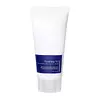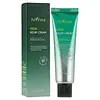What's inside
What's inside
 Key Ingredients
Key Ingredients

 Benefits
Benefits

 Concerns
Concerns

No concerns
 Ingredients Side-by-side
Ingredients Side-by-side

Water
Skin ConditioningButylene Glycol
HumectantGlycerin
HumectantCaprylic/Capric Triglyceride
Masking1,2-Hexanediol
Skin ConditioningLonicera Japonica Flower Extract
Skin ConditioningArtemisia Annua Extract
MaskingSodium Hyaluronate
HumectantCamellia Sinensis Leaf Extract
AntimicrobialCeramide NP
Skin ConditioningAcetic Acid
BufferingAmmonium Acryloyldimethyltaurate/Vp Copolymer
Glyceryl Stearate
EmollientAcrylates/C10-30 Alkyl Acrylate Crosspolymer
Emulsion StabilisingArginine
MaskingOctyldodecanol
EmollientEthylhexylglycerin
Skin ConditioningWater, Butylene Glycol, Glycerin, Caprylic/Capric Triglyceride, 1,2-Hexanediol, Lonicera Japonica Flower Extract, Artemisia Annua Extract, Sodium Hyaluronate, Camellia Sinensis Leaf Extract, Ceramide NP, Acetic Acid, Ammonium Acryloyldimethyltaurate/Vp Copolymer, Glyceryl Stearate, Acrylates/C10-30 Alkyl Acrylate Crosspolymer, Arginine, Octyldodecanol, Ethylhexylglycerin
Water
Skin ConditioningCentella Asiatica Extract
CleansingDipropylene Glycol
HumectantCaprylic/Capric Triglyceride
MaskingGlycerin
HumectantHydrogenated Polydecene
EmollientCetearyl Alcohol
EmollientBeeswax
Emulsion StabilisingCoco-Caprylate/Caprate
Emollient1,2-Hexanediol
Skin ConditioningCetearyl Olivate
Glyceryl Stearate
EmollientLeontopodium Alpinum Callus Culture Extract
AntioxidantMelia Azadirachta Leaf Extract
Skin ConditioningMelia Azadirachta Flower Extract
Skin ConditioningCoccinia Indica Fruit Extract
Skin ConditioningAmber Powder
Solanum Melongena Fruit Extract
Skin ConditioningCurcuma Longa Root Extract
MaskingOcimum Sanctum Leaf Extract
Skin ConditioningCorallina Officinalis Extract
Skin ConditioningHydrogenated Lecithin
EmulsifyingGlyceryl Caprylate
EmollientMoringa Oleifera Seed Oil
EmollientAsiaticoside
AntioxidantSh-Oligopeptide-1
Skin ConditioningAcetyl Hexapeptide-8
HumectantPalmitoyl Tripeptide-1
Skin ConditioningCopper Tripeptide-1
Skin ConditioningPhosphatidylcholine
EmulsifyingPanthenol
Skin ConditioningAllantoin
Skin ConditioningPalmitic Acid
EmollientCetearyl Glucoside
EmulsifyingHydroxyethyl Acrylate/Sodium Acryloyldimethyl Taurate Copolymer
Emulsion StabilisingAdenosine
Skin ConditioningXanthan Gum
EmulsifyingC12-16 Alcohols
EmollientMicrocrystalline Cellulose
AbsorbentCellulose Gum
Emulsion StabilisingDextrin
AbsorbentSorbitan Olivate
EmulsifyingButylene Glycol
HumectantEthylhexylglycerin
Skin ConditioningWater, Centella Asiatica Extract, Dipropylene Glycol, Caprylic/Capric Triglyceride, Glycerin, Hydrogenated Polydecene, Cetearyl Alcohol, Beeswax, Coco-Caprylate/Caprate, 1,2-Hexanediol, Cetearyl Olivate, Glyceryl Stearate, Leontopodium Alpinum Callus Culture Extract, Melia Azadirachta Leaf Extract, Melia Azadirachta Flower Extract, Coccinia Indica Fruit Extract, Amber Powder, Solanum Melongena Fruit Extract, Curcuma Longa Root Extract, Ocimum Sanctum Leaf Extract, Corallina Officinalis Extract, Hydrogenated Lecithin, Glyceryl Caprylate, Moringa Oleifera Seed Oil, Asiaticoside, Sh-Oligopeptide-1, Acetyl Hexapeptide-8, Palmitoyl Tripeptide-1, Copper Tripeptide-1, Phosphatidylcholine, Panthenol, Allantoin, Palmitic Acid, Cetearyl Glucoside, Hydroxyethyl Acrylate/Sodium Acryloyldimethyl Taurate Copolymer, Adenosine, Xanthan Gum, C12-16 Alcohols, Microcrystalline Cellulose, Cellulose Gum, Dextrin, Sorbitan Olivate, Butylene Glycol, Ethylhexylglycerin
 Reviews
Reviews

Ingredients Explained
These ingredients are found in both products.
Ingredients higher up in an ingredient list are typically present in a larger amount.
1,2-Hexanediol is a synthetic liquid and another multi-functional powerhouse.
It is a:
- Humectant, drawing moisture into the skin
- Emollient, helping to soften skin
- Solvent, dispersing and stabilizing formulas
- Preservative booster, enhancing the antimicrobial activity of other preservatives
Butylene Glycol (or BG) is used within cosmetic products for a few different reasons:
Overall, Butylene Glycol is a safe and well-rounded ingredient that works well with other ingredients.
Though this ingredient works well with most skin types, some people with sensitive skin may experience a reaction such as allergic rashes, closed comedones, or itchiness.
Learn more about Butylene GlycolThis ingredient is an emollient, solvent, and texture enhancer. It is considered a skin-softener by helping the skin prevent moisture loss.
It helps thicken a product's formula and makes it easier to spread by dissolving clumping compounds.
Caprylic Triglyceride is made by combining glycerin with coconut oil, forming a clear liquid.
While there is an assumption Caprylic Triglyceride can clog pores due to it being derived from coconut oil, there is no research supporting this.
Learn more about Caprylic/Capric TriglycerideEthylhexylglycerin (we can't pronounce this either) is commonly used as a preservative and skin softener. It is derived from glyceryl.
You might see Ethylhexylglycerin often paired with other preservatives such as phenoxyethanol. Ethylhexylglycerin has been found to increase the effectiveness of these other preservatives.
Glycerin is already naturally found in your skin. It helps moisturize and protect your skin.
A study from 2016 found glycerin to be more effective as a humectant than AHAs and hyaluronic acid.
As a humectant, it helps the skin stay hydrated by pulling moisture to your skin. The low molecular weight of glycerin allows it to pull moisture into the deeper layers of your skin.
Hydrated skin improves your skin barrier; Your skin barrier helps protect against irritants and bacteria.
Glycerin has also been found to have antimicrobial and antiviral properties. Due to these properties, glycerin is often used in wound and burn treatments.
In cosmetics, glycerin is usually derived from plants such as soybean or palm. However, it can also be sourced from animals, such as tallow or animal fat.
This ingredient is organic, colorless, odorless, and non-toxic.
Glycerin is the name for this ingredient in American English. British English uses Glycerol/Glycerine.
Learn more about GlycerinGlyceryl Stearate is a mix of glycerin and stearic acid.
It is used to stabilize the mixing of water and oil ingredients. By preventing these ingredients from separating, it can help elongate shelf life. It can also help thicken the product's texture.
As an emollient, it helps soften skin and supports barrier-replenishing ingredients.
In cosmetics, Glyceryl Stearate is often made from vegetable oils or synthetically produced.
This ingredient may not be fungal-acne safe
Fun fact: The human body also creates Glyceryl Stearate naturally.
Learn more about Glyceryl StearateWater. It's the most common cosmetic ingredient of all. You'll usually see it at the top of ingredient lists, meaning that it makes up the largest part of the product.
So why is it so popular? Water most often acts as a solvent - this means that it helps dissolve other ingredients into the formulation.
You'll also recognize water as that liquid we all need to stay alive. If you see this, drink a glass of water. Stay hydrated!
Learn more about Water